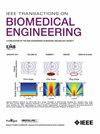Deep Learning-Based Tract Classification of Preoperative DWI Tractography Advances the Prediction of Short-Term Postoperative Language Improvement in Children With Drug-Resistant Epilepsy
IF 4.4
2区 医学
Q2 ENGINEERING, BIOMEDICAL
引用次数: 0
Abstract
基于深度学习的术前 DWI 节段成像分类有助于预测耐药癫痫患儿术后短期语言改善情况
目的:开发一种创新的基于深度卷积神经网络(DCNN)的神经束分类方法,利用来自术前全脑弥散加权成像连接组(wDWIC)内特定语言模块网络(lns)的轴突连通性标记物,增强对术后短期语言改善的预测。方法:采用三步法。首先,我们使用开源的高质量wDWIC数据库扩展了之前基于dcnn的真阳性泪道分类方法,以促进个体患者术前骨干wDWIC中真阳性泪道的准确分类。接下来,我们将心理测量驱动的wwic分析应用于所得到的基于dcnn的主干wwwic,以创建核心、表达性和接受性lnn。最后,在三个LMN中评估基于图和电路理论的连接标记,并使用一系列机器学习算法进行比较,以预测给定LMN术后语言改善的存在。结果:结果表明,扩展DCNN通道分类显著提高了连接标记在不同lmn之间的f统计量的可重复性,最高可达35.5%。在不同的机器学习算法中,预测精度提高了40 %。值得注意的是,在独立验证队列中,最佳算法在预测术后两个月左右核心/表达/接受域的语言改善方面达到了96$\% /94$\% /96$\%的准确率。结论:这些领域具有很大的潜力,可以帮助医生识别那些语言技能从早期手术中受益的候选人。意义:DCNN束分类可能是预测小儿癫痫术后短期语言改善的有效工具。
本文章由计算机程序翻译,如有差异,请以英文原文为准。
求助全文
约1分钟内获得全文
求助全文
来源期刊

IEEE Transactions on Biomedical Engineering
工程技术-工程:生物医学
CiteScore
9.40
自引率
4.30%
发文量
880
审稿时长
2.5 months
期刊介绍:
IEEE Transactions on Biomedical Engineering contains basic and applied papers dealing with biomedical engineering. Papers range from engineering development in methods and techniques with biomedical applications to experimental and clinical investigations with engineering contributions.
 求助内容:
求助内容: 应助结果提醒方式:
应助结果提醒方式:


